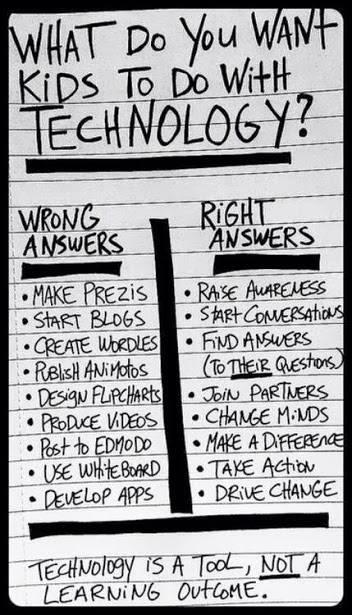
What do we really want students to be able to do with technology? Sometimes blended learning or the integration of specific tools is held up as the goal when really they are the means to achieving a higher purpose: high-quality, optimal learning experiences for each and every student.
 This poster says it all: (posted by @NikkiDRobertson on Twitter)
This poster says it all: (posted by @NikkiDRobertson on Twitter)
When planning how to integrate technology tools, there are several models that educators can reference. There’s the SAMR model that shows how adopters of education technology progress from levels of substitution, augmentation, modification, and redefinition. There are the type of adopters (Diffusion of Innovations) from innovators, early adopters, early majority, late majority, and laggards. And, the Levels of Adoption range from the initial training to exploration to transformation.
Each of these models first focuses on the technology and the instructor. What’s the initiative this year? iPads? Whiteboards? How do we get teachers to use them?
Instead we should ask: What are our goals for learning? Who are our learners? Then, what tools would suit our learners and their learning needs best so that they achieve and even exceed the goals?
To focus on what’s most important, we need a learner-centered approach to considering technology integration. As Lessoncast works with schools to support personalized instruction, we’ve developed a Learner-Centered Hierarchy for Blended Learning. A cross between Bloom’s Taxonomy and Maslow’s Hierarchy of Needs, it considers the opportunities that technology offers and the new realities of 21st century learning. This model first focuses on the purposes for learning – moving from simple to complex, and then each level considers what tools and resources meet that need.

Level 1: Content Acquisition
The most basic use of blended learning is to provide options for content acquisition. The teacher is not the sole source of content delivery, and digital content allows learners to access content at their level, at their pace, and in light of their interests. Content acquisition may take the form of articles, videos, flipped lessons, or online curriculum.
Key Learning Tasks: view, read, outline, tell about, restate, summarize, write about, review, study, recognize, observe, quote, point to, name, list, label, identify, describe, define
Tools & Resources:
- Brain POP
- Course World – Arts and Humanities Videos
- Discovery Education
- Informed by Nature – Virtual Bookshelf
- PBS Video
- SciGirls Connect
Level 2: Skill Practice
Traditional drill and kill worksheets may have tarnished the image of practice, but there is value in learners engaging in meaningful practice at an appropriately challenging level. Where would musicians, dancers, and athletes be without practice? In those examples, a good coach or teacher ensures that the learner’s practice activity is matched to what the learner needs for optimal growth.
Blended learning can facilitate that matching process and should replace paper worksheets as much as possible. It’s a common classroom sight to see all of the students completing the same worksheet at the same time. Some are finished early and aren’t properly challenged; others never make it all the way through; feedback happens days later when the papers go home in a folder. Using blended learning tools each learner can practice at a level and pace optimal for him and ideally receive immediate feedback.
Key Learning Tasks: calculate, categorize, estimate, compare, contrast, match, interpret, illustrate, manipulate, predict, relate, trace, clarify, differentiate, generalize, chart, sort
Tools & Resources:
Level 3: Creative Consumption
Digital technologies provide new opportunities for learners to create and produce, not just consume and practice. At the Creative Consumption Level, learners build on newly acquired content knowledge and skills and apply their learning by creating an artifact that demonstrates their understanding. Learners synthesize information and often publish their work. Creative consumption can include blogging, programming, gaming, and design work. This NY Times article describes numerous ideas for teaching with infographics across and within multiple subject areas.
This lesson idea featured below is an example of Creative Consumption.
[lesson id=”18285″ width=”640″ height=”360″ show_link=”true” description=”Incorporating infographics helps students create, negotiate, interpret, and make meaning of data through visual representations. This lesson idea guides students through the process of creating infographics to illustrate the issues affecting the health of the Chesapeake Bay.” /]
Key Learning Tasks: apply, adapt, construct, create, develop, exhibit, make, synthesize, perform, produce, show, demonstrate, change, solve, build, assemble, invent, design, form, formulate, generate, model, publish, graph, analyze, diagram, document, edit
Tools & Resources:
Level 4: Collaborative Space
Collaboration requires learners to not only create but also exchange ideas with others. Social media and new digital tools and platforms make it possible for students to connect with peers in their community and at a distance, experts in various fields, and affinity groups. Blended learning doesn’t achieve the full potential of 21st century technology if it only encompasses individual, isolated online coursework. At this level, collaboration opportunities could range from Google docs to creating an open classroom wikipedia to contributing to an online science fair. This article provides interesting guides on using Google services for this type of blended learning.
Key Learning Tasks: exchange, modify, give feedback, debate, collaborate, consider, optimize, refine, join, synthesize, respond, blend, combine, improve, incorporate, integrate, appreciate, defend, influence, recommend, support, value, rate, survey
Tools & Resources:
- ActiveBoard
- ed.Voicethread
- Edmodo
- Game Design Toolkit
- Google in Education – Collaboration Tools
- Online Science Fair
- Project Noah
- Wikispaces
- Zooniverse
Level 5: Self-driven Learning
The highest form of blended learning is Self-driven Learning – blended options that allow the learner to navigate, explore, experience, create, collaborate, and drive her own learning. This level is not easy for teachers to implement, and – after years of being told the question and the steps for solving it – many students may not initially care for this type of learning experience. But if we are to truly help learners achieve their full potential in a global society, we must consider the blended options for supporting self-driven learning. One method is to incorporate learning menus or playlists, where content has been curated and students can choose the path that best suits and most interests them. Students can also take the lead in content curation; teachers frame the essential question, and students curate the content and resources to meet the learning challenge. This post by Alex Hernandez provides a glimpse of what a self-driven blended learning approach looks like in a DC classroom. This lessoncast demonstrates how two teachers enabled students to lead the content curation process to facilitate STEM learning.
Click to view full details and attachments
Key Learning Tasks: navigate, choose, compile, evaluate, justify, connect, coordinate, cultivate, establish, explore, organize, plan, test, inquire, critique, assess, hypothesize, prioritize, measure, verify, validate, prove, ask, reason, refine, reflect
Tools & Resources:
All of the resources from levels 1-4 can be used to facilitate self-driven blended learning. The key is to developing essential questions, learning menus, playlists, or learning plans to assist students in navigating their path.
Applying the Hierarchy to Implement Blended Learning
In planning, educators should ask the questions from the beginning of this post:
- What are our goals for learning?
- Who are our learners?
- What tools would suit our learners and their learning needs best so that they achieve and even exceed the goals?
A fourth question that educators need to ask in planning is:
How will we know if students are learning and achieving the desired outcomes?
Next entry: Embedded Assessment
Side Note: Above, I’ve listed a few tools and resources that I’ve found helpful. Of course this list is incomplete. We’re in the process of compiling a more extensive resource list, which we’ll post. If you have any suggestions or ideas, feel free to post them in the comments section below.

